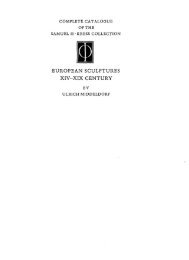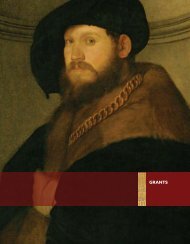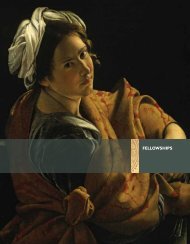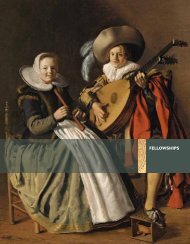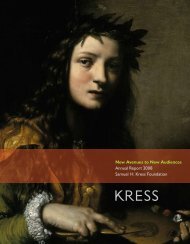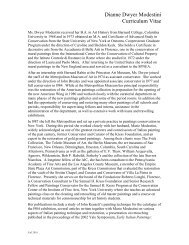The Campus Art Museum - Samuel H. Kress Foundation
The Campus Art Museum - Samuel H. Kress Foundation
The Campus Art Museum - Samuel H. Kress Foundation
Create successful ePaper yourself
Turn your PDF publications into a flip-book with our unique Google optimized e-Paper software.
It is important to ask “What do you see?”… and then, they start asking<br />
questions…. It gives them the chance to wonder. Right now students are so<br />
fastened down, and it is so important for them to wonder about things and to<br />
have questions.<br />
James Cuno (2004, 21), President and CEO of the J. Paul Getty Trust and,<br />
until recently, President and Director of the <strong>Art</strong> Institute of Chicago, also discusses<br />
the importance of wonder, stating that he wants to “recover this sense of wonder<br />
as part of the museum’s purpose and as integral to its contract with the public.”<br />
Wonder is accompanied by a range of emotions that engage the beholder. An art<br />
history graduate student, now specializing in the Renaissance, described the awe<br />
she felt before the work of Botticelli before she knew who Botticelli was:<br />
I remember walking around Florence and seeing these images of Botticelli’s<br />
Birth of Venus everywhere and I had no idea what is was and I just thought,<br />
why is this image everywhere? I remember walking into the Uffizi. We were on<br />
a kind of whirlwind tour and I remember walking into that room and shivers<br />
ran down my spine. <strong>The</strong>re was this physical reaction…. This has happened to<br />
me a couple times but that was one of the first. I was absolutely shocked by the<br />
beauty of the thing, this other-worldly beauty.<br />
A business professor involves her accounting students in the campus art<br />
museum. When asked about their reactions to the museum, she received responses<br />
such as, “Wow, I didn’t know that was here. I’m going to come back again.” She also<br />
“got a couple of really strong responses” to an exhibition by a Romanian resident<br />
artist who used black markers to draw on the wall:<br />
He did some drawings and one of them was a picture of a vampire and<br />
underneath it said banker…. Some students were really offended by that. It was<br />
a really strong reaction. <strong>The</strong> comments I got in the write-up were “Who does<br />
he think is going to buy art? Who does he think supports the arts? Banks buy<br />
art”…. I think the thought that [the artist] would have been very happy with<br />
their response was lost on them. He really got them to engage and think hard<br />
about the relationship between business and art.<br />
Whether shocked by beauty or personally offended, it is the power of the object to<br />
engage, that process of experiencing, that begets the curiosity and excitement to<br />
know more or to more deeply examine personal values.<br />
Faculty and curators also mention how, invariably, some students excel<br />
in the museum environment in ways they do not in the regular classroom<br />
because art taps into personal interests, knowledge bases, and creativity. For<br />
example, a German professor who took her students to the museum told about a<br />
student “whose German wasn’t very good, so class time wasn’t easy for him, not<br />
a very dedicated student perhaps but he connected with the posters…. He gave a<br />
wonderful presentation and I hadn’t anticipated that, but was thrilled that he found<br />
something in this class to connect with.” Incorporating the museum and<br />
<strong>The</strong> Power of the Original<br />
32



